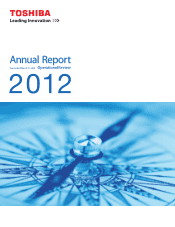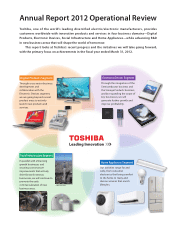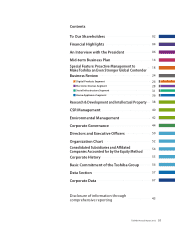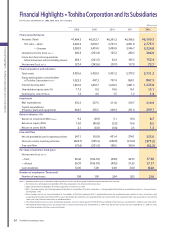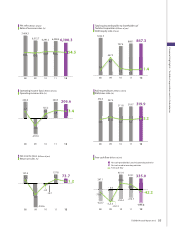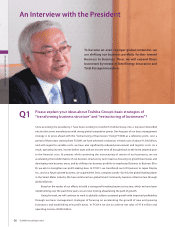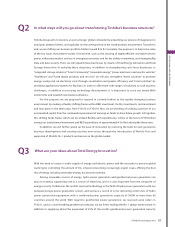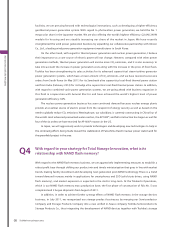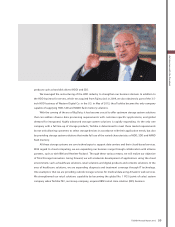Toshiba 2012 Annual Report Download - page 10
Download and view the complete annual report
Please find page 10 of the 2012 Toshiba annual report below. You can navigate through the pages in the report by either clicking on the pages listed below, or by using the keyword search tool below to find specific information within the annual report.
facilities, we are pressing forward with technological innovations, such as developing a higher-efficiency
geothermal power generation system. With regard to photovoltaic power generation, we hold the No. 1
mega solar share in the Japanese market. We are also offering the world’s highest efficiency (22.6%) 240W
module for housing and are steadily increasing our share of the market in Japan. We have recently
strengthened the wind power generation business by expanding our collaborative partnership with Unison
Co., Ltd., a leading wind power generation equipment manufacturer in South Korea.
On the other hand, with regard to thermal power generation and nuclear power generation, I believe
their importance as a core source of electric power will not change. However, compared with other power
generation methods, thermal power generation will involve more CO2 emissions, and it is also necessary to
take into account the increase in power generation costs along with the increase in the price of fossil fuels.
Toshiba has been strengthening its sales activities for its advanced supercritical steam turbine generator
power generation systems, which have a lower amount of CO2 emissions, and we have received successive
orders from South Korea (in May 2011) for its Samcheok ultra supercritical coal-fired thermal power station
and from India (February 2012) for its Kudgi ultra supercritical coal-fired thermal power station. In addition,
with regard to combined-cycle power generation systems, we are going ahead with business expansion in
this field in cooperation with General Electric and have achieved the world’s highest level of power
generation efficiency: 62%.
The nuclear power generation business has seen continued demand because nuclear energy plants
provide an essential source of electric power from the viewpoint of energy security as well as based on the
need to globally reduce CO2 emissions. Westinghouse, our subsidiary, is currently constructing in China four of
the world’s most advanced pressurized-water reactors, the AP1000®, and full construction has begun as well for
four of the six orders we have received for AP1000® reactors in the U.S.
In Japan, we will aggressively work to provide technologies and developing new technologies to help in
the continuing e orts being made toward the stabilization of Fukushima Daiichi nuclear power station and for
the green eld project in the area.
With regard to the NAND flash memory business, we are aggressively implementing measures to establish a
robust profit base through shifting our product mix and timely miniaturization that goes in line with market
trends, making facility investment and developing next-generation post-NAND technology. There is a trend
toward demand increase mainly in applications for smartphones and SSD (solid state drives, using NAND
flash memory), and market expansion is expected in the mid-to long-term. At the Yokkaichi Operations,
which is our NAND flash memory mass production base, the first phase of construction of Fab No. 5 was
completed and it began shipments from August of 2011.
In addition, in order to achieve further synergy effects of NAND flash memory in the storage devices
business, in July 2011, we reorganized our storage product businesses by merging our Semiconductor
Company and Storage Products Company into a new unified in-house company Toshiba Semiconductor &
Storage Products Co., thus integrating the development of NAND devices together with Toshiba’s storage
With regard to your strategy for Total Storage Innovation, what is its
relationship with NAND ash memory?
Q4
An Interview with the President
08 TOSHIBA Annual Report 2012

